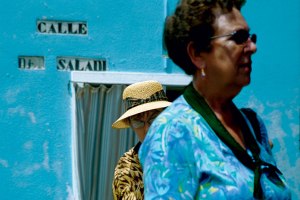 Summer season group shows can be a sluggish and bland affair, but the Wapping Project Bankside has brought together a clutch of work form their best international photographers for their end of season Gallery Artists’ Review. This looking back, forward and now seems well-suited to these last dog-end days of summer, as autumn looms with renewed responsibilities and fresh vigour.
Summer season group shows can be a sluggish and bland affair, but the Wapping Project Bankside has brought together a clutch of work form their best international photographers for their end of season Gallery Artists’ Review. This looking back, forward and now seems well-suited to these last dog-end days of summer, as autumn looms with renewed responsibilities and fresh vigour.
Fashion photographer Deborah Turbeville, the 76-year-old New Yorker and regular contributor to Italian Vogue soaks her images in characteristic opiate nostalgia. Gazing mannequins and poised marionettes hang suspended in the powdery soft focus of ‘Steam Bath’, while others resonate in Eastern bloc tableaux, fading like retina burn behind a filmy surface as fragile as crumbling plaster. Fellow photographer and nonagenarian Lillian Bassman’s monochromatic pictures are often described as stylised and calligraphic, but these fashion images show miraculous and haunting beings, a touch vampish, shot against grainy clouds of backlight, like beautiful nocturnal creatures against the never dark sky of a white night. This eerie chord finds echoes in the precise and orchestrated interiors of young British photographer Annabel Elgar; ‘The Rally’ shows a grizzly bear’s head staked to the wall, it’s peeled open mouth preaching at an empty makeshift outdoor auditorium with ghostly lectern and red chairs menacing in the near dawn light. In her world, smudged window panes, dirty sinks and cloudy mirrors absorb the light and whisper a gentle anxiety, similar to that of summer closing and the autumnal nights creeping slowly in.
Peter Marlow’s reportage series of filmic night shots of the East End document scenes of abandonment; from alleyways iridescent with the sheen of rain soaked concrete, to cars, construction sites and street corners. His images coerce the mundane quotidian furniture of life such as streetlights and pylons, window frames and bus shelters into narratives pregnant with suspense and intrepidation, as if seen through the eyes of a pulp fiction flaneur. Stephen J Morgan does something similar, but more kitsch and in muted technicolour , documenting autobiographical details of working class, inner-city life such as the working man’s club in ‘Where my Grandfather Sang’, that are reminiscent of Richard Billingham. Morgan frames a lonely Madonna, staring beseechingly from her perch, nodding in the direction of two stills from Susan Meiselas’ Pandora’s Box series, where stilettoed hookers hang around in neo- baroque interiors, waiting for sex or recovering from it, boxed into carpeted rooms of sea blue crushed velvet, like mermaids trapped in formaldehyde.
Which leaves the cooling balm of Finnish photographer and filmmaker Elina Brotherus, next in line for a solo show at Wapping bankside, which opens on 16 September. Brotherus plays with landscapes and the body, documenting the lush glades and pools of her motherland, in scenes that echo 20th century late Impressionist painting. A refreshing invitation to Wapping Bankside’s autumn programme indeed.
Catherine McCormack
